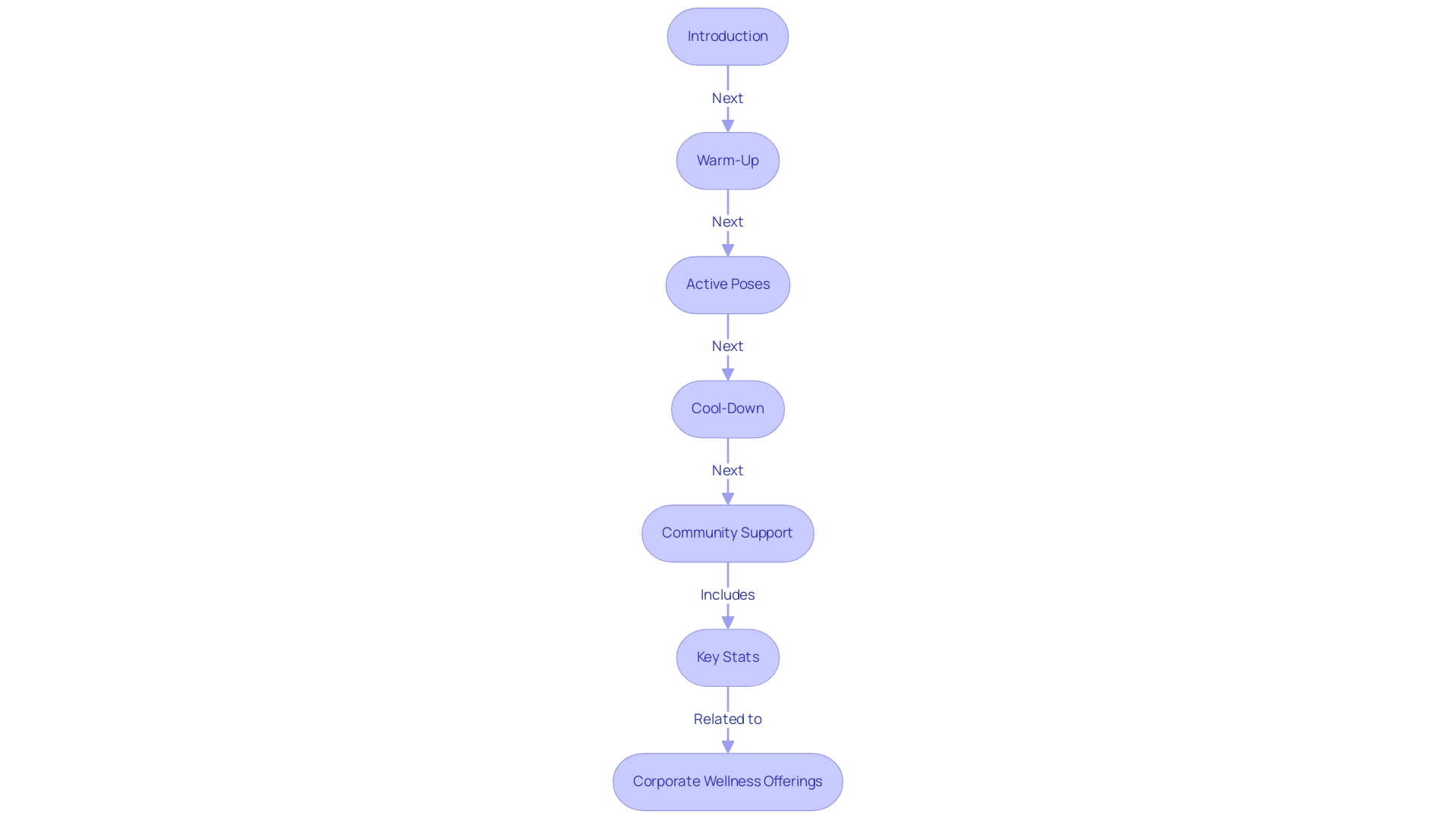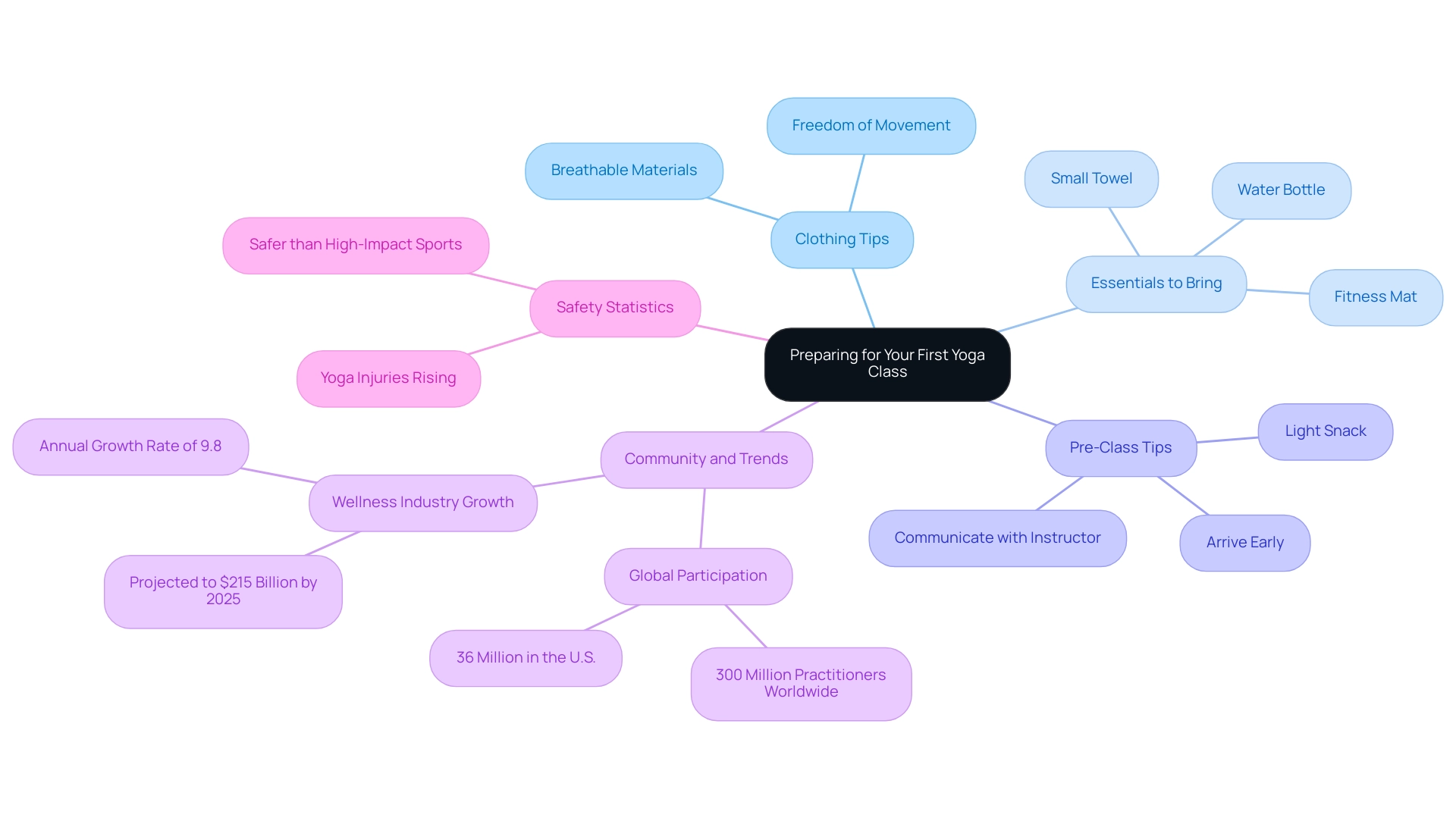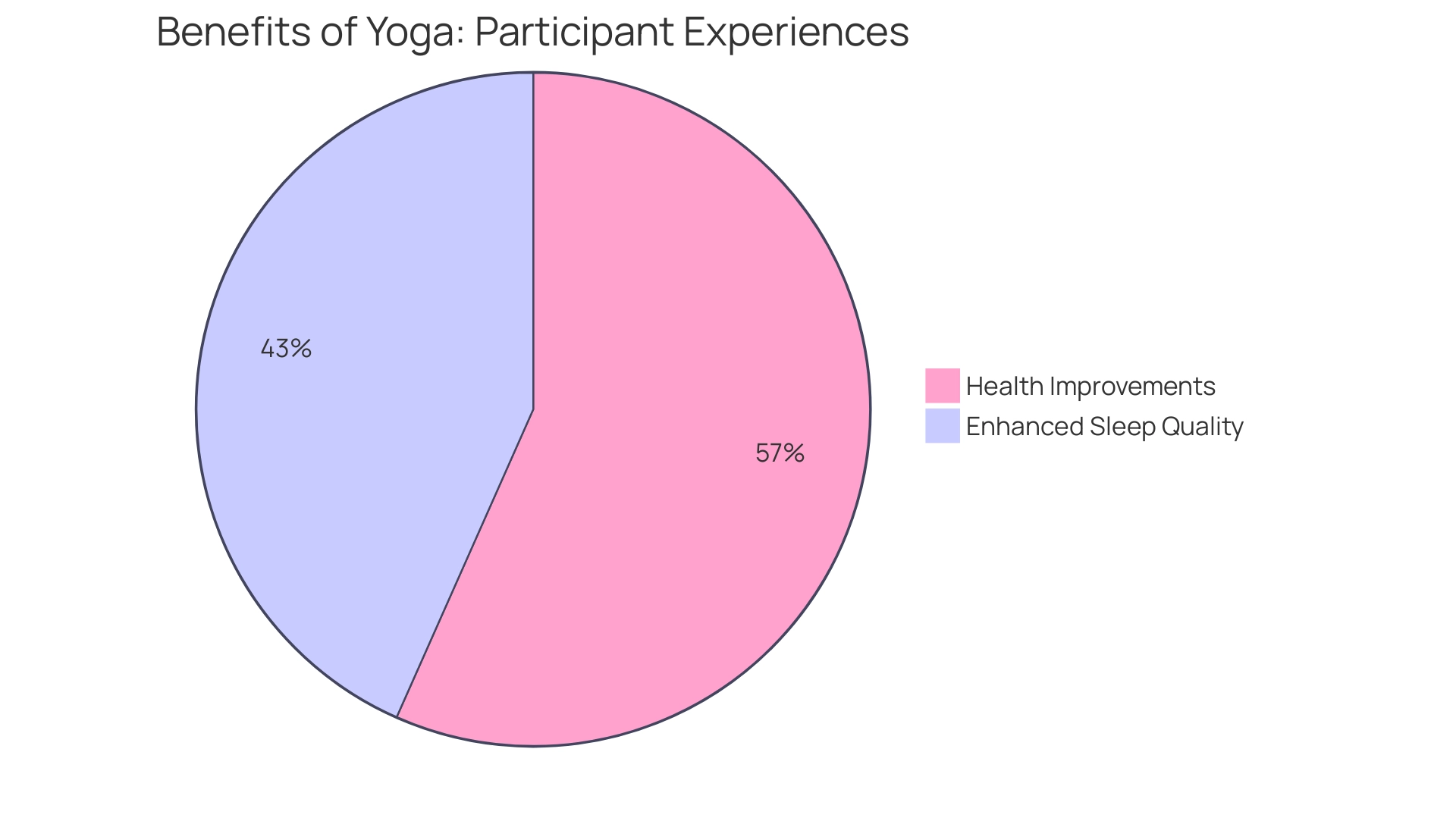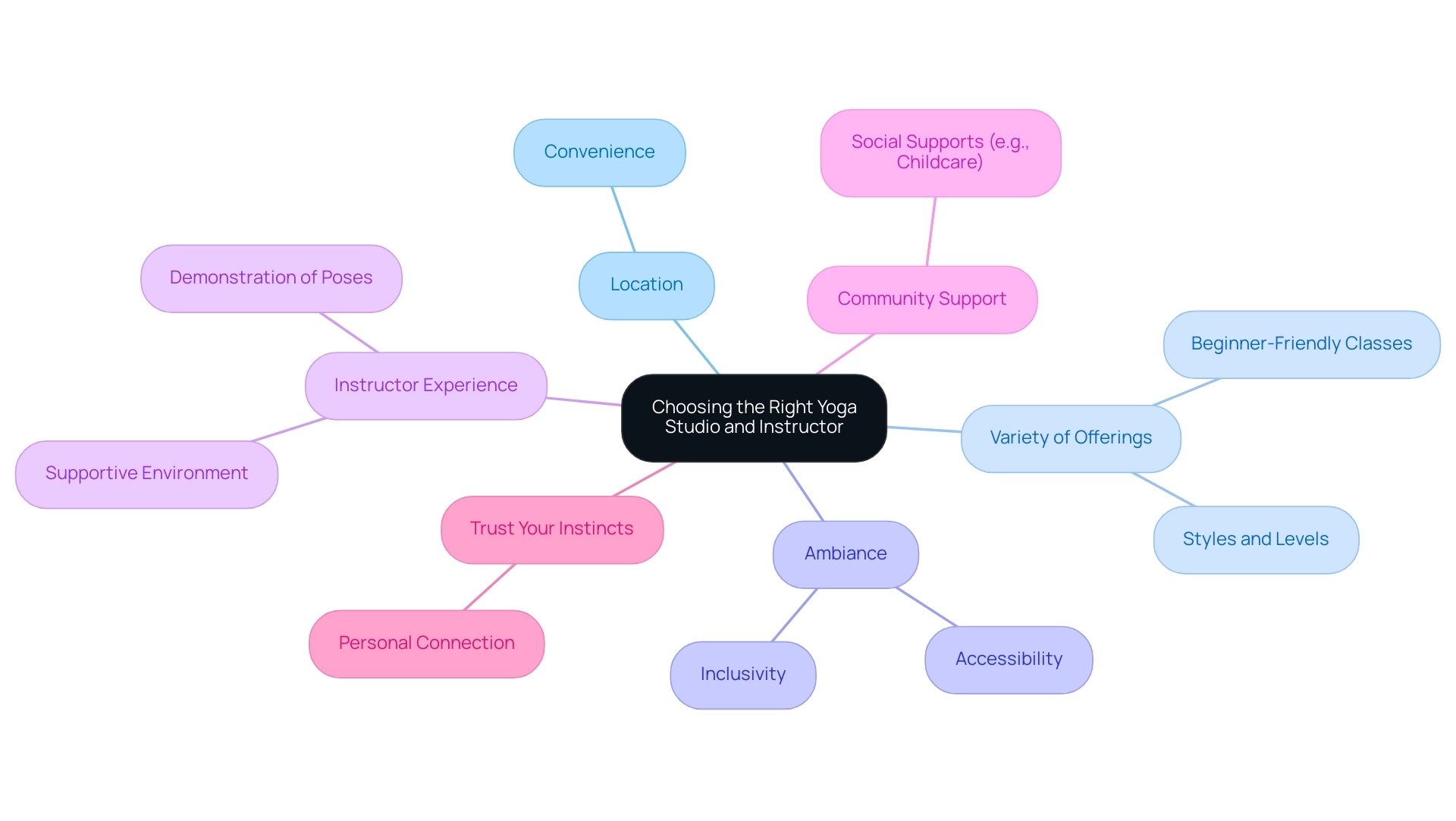Overview
This article serves as a comprehensive guide for beginners attending their first free yoga class, emphasizing the critical importance of:
- Maintaining an open mindset
- Thorough preparation
- A clear understanding of class structure
It highlights the welcoming atmosphere prevalent in yoga sessions, alongside the myriad mental and physical benefits associated with regular practice. Practical tips are provided to ensure a positive experience, ultimately encouraging newcomers to embrace their yoga journey with confidence and enthusiasm.
Introduction
Embarking on a yoga journey can evoke a blend of excitement and apprehension, particularly for those stepping onto the mat for the first time. This ancient practice transcends mere physical postures, fostering a profound connection between breath and mindfulness. As yoga's popularity surges—evident from the increasing number of participants seeking its myriad benefits—understanding what to expect in a class becomes essential for newcomers. By preparing adequately and embracing the supportive environment that yoga cultivates, beginners can transform their initial nerves into a rewarding experience that enhances both mental and physical well-being.
Embracing Your First Yoga Experience: What to Know
Embarking on your yoga journey can be both exhilarating and intimidating. To maximize your experience during the complimentary first class, approach it with an open mind and a readiness to learn. Yoga transcends mere physical postures; it encompasses a profound connection with your breath and a focus on being present in the moment.
It's crucial to remember that every participant in the class was once a beginner, fostering a typically supportive and encouraging atmosphere. Statistics indicate that 43% of individuals express feeling very happy after a session, underscoring the positive emotional effects of the activity. Furthermore, yoga-based interventions are increasingly recognized as effective alternatives for addressing mood disorders, making it a valuable tool for mental well-being. In fact, 21% of Americans reported having tried this practice at least once in the past year, an increase from 18% in 2012, reflecting its growing popularity.
As you prepare for your first class, consider these tips:
- Be Open to Learning: Embrace the journey and allow yourself to explore the various aspects of yoga.
- Ask Questions: Don’t hesitate to seek guidance from your instructor; they are there to assist you.
- Focus on Your Breath: Connecting with your breath is fundamental in this practice, enhancing your overall experience.
- Mindset Matters: Cultivating a positive mindset is crucial when beginning this practice. It establishes the tone for your routine and assists you in navigating challenges.
In 2025, numerous newcomers convey feeling encouraged in sessions, particularly those who experienced yoga's complimentary first class, with a notable proportion sharing favorable encounters. This supportive environment can significantly enhance your practice, making it easier to engage and grow. During your complimentary first class, expect to encounter a variety of poses and techniques, and remember that it's perfectly normal to feel a mix of excitement and nervousness.
Successful initial sessions in physical practice frequently arise from a blend of preparation and attitude. By understanding what to expect and approaching the class with curiosity, you can set the stage for a fulfilling journey. As the wellness industry continues to thrive, with nearly $18 billion spent annually and projected revenue increases, the growing popularity of this practice reflects its profound impact on mental health and overall well-being.
As George Watts, a BWY instructor, notes, "According to the same study by the Yoga Journal, 21% of U.S. adults had tried the practice in the past year, up from 18% in 2012." Therefore, step onto your mat with confidence, and enjoy the transformative experience that yoga has to offer.

Understanding the Class Environment and Structure
Yoga sessions typically commence with a brief introduction, allowing participants to settle into the space and center their minds. This initial moment of stillness is crucial for fostering a focused mindset, aligning seamlessly with Foresight Health Coaching's holistic approach to wellness. Instructors guide attendees through a series of poses, beginning with gentle stretches and gradually increasing in intensity, tailored to the group's specific style—ranging from restorative practices to more vigorous flows.
The atmosphere of a yoga session significantly influences participant engagement. In 2025, many courses emphasize a serene environment, often featuring soft music or complete silence, which enhances concentration and mindfulness. This tranquil setting not only supports the approach but also complements the comprehensive health coaching services provided by Foresight, including fitness coaching, nutritional guidance, and wellness workshops tailored for corporate environments.
For novices, understanding the framework of a standard session is essential, especially when they can take advantage of yoga's first class free. Classes generally last between 60 to 90 minutes, featuring a balanced mix of warm-up, active poses, and a cool-down period. This structure not only aids in building strength and flexibility but also ensures participants can gradually acclimate to the practice, paralleling the personalized coaching plans Foresight offers to support individual health journeys.
It's important for newcomers to remember that modifications are encouraged. Listening to one's body is key, and taking breaks when necessary is a vital part of the learning process. The average group size for beginner yoga sessions, where one can enjoy a yoga first class free, tends to be around 10 to 15 participants, fostering a supportive environment where individual attention can be given.
This reflects Foresight's dedication to providing customized interactions for all clients, whether in a corporate environment or personal sessions. Instructors often emphasize the importance of community and connection during class introductions, setting a tone of inclusivity and support. This method not only enhances overall interaction but also motivates participants to engage more fully with their practice.
As this practice continues to grow in popularity—with approximately 36 million Americans participating, a significant portion of whom are female and well-educated—understanding these elements can significantly enhance the experience for beginners while integrating seamlessly into Foresight's broader wellness initiatives. Moreover, a study conducted by Harvard Medical School explored the effects of hot exercise on adults with depression, finding that approximately 60% of participants experienced a significant reduction in symptoms. This underscores the potential mental health advantages of this practice, aligning perfectly with the wellness focus of Foresight Health Coaching, which aims to empower clients through tailored health solutions.
Foresight provides corporate memberships that accommodate up to 30 employees, featuring in-person wellness discussions, extensive pantry services, and a white-glove service to guarantee a premium offering. The cost of the membership scales with the number of employees, providing flexibility for organizations of all sizes. Additionally, the average practitioner spends about $120 per year on wellness-related products, indicating a strong investment in personal health that HR Benefits Managers may want to consider when promoting health initiatives within their organizations.

Preparing for Your First Class: Tips and Essentials
Preparing for your first yoga class can be both an exciting and nerve-wracking experience. To ensure comfort and readiness, it is essential to wear clothing that allows for freedom of movement. Opt for breathable materials like leggings or shorts paired with a fitted top; comfortable attire is crucial for a positive experience.
Experts note that the right clothing can significantly enhance your practice, allowing you to focus on your movements rather than adjusting your outfit. Furthermore, there are a few essentials to bring along:
- A fitness mat is vital, providing the necessary grip and cushioning.
- Don't forget a water bottle to stay hydrated.
- A small towel to wipe away any sweat during your session.
These items not only serve practical purposes but also contribute to a more enjoyable and effective practice.
Arriving early—ideally 15 to 20 minutes before class—can help you acclimate to the environment. This time allows you to settle in, introduce yourself to the instructor, and discuss any injuries or concerns you may have. Open communication with your instructor is vital; they can offer modifications tailored to your needs, ensuring a safe and supportive experience.
For optimal energy levels, consider eating a light snack about an hour before the session. This can help maintain your stamina without the discomfort of a full stomach. Statistics indicate that beginners who prepare adequately for their first yoga class report a more positive experience, with many feeling more motivated to continue their practice.
As you embark on this journey, remember that yoga is a personal practice, and everyone progresses at their own pace. With approximately 300 million individuals engaging in this practice worldwide, you're joining a global community that values health and wellness. The wellness industry is projected to grow to $215 billion by 2025, reflecting its rising popularity and significance in today's health culture.
While injuries from this practice are increasing, it remains statistically safer than many high-impact sports, providing reassurance for beginners. Embrace the experience and enjoy the benefits that this practice can bring to your life. Additionally, trends indicate that many newcomers prefer online fitness classes, with 40.8% of respondents in Japan favoring this format for a more carefree participation.
In Australia, 39% of workouts involve gentler sequences that include breathing techniques and meditation, which may appeal to those new to the practice.

The Benefits of Yoga: Why You Should Keep Practicing
Yoga offers a multitude of benefits that transcend mere physical fitness, encompassing enhanced flexibility, strength, and balance. Regular practice proves particularly effective in boosting mental clarity and alleviating stress—elements vital for sustaining a productive work environment. Research reveals that:
- 89.5% of participants experienced health improvements due to yoga.
- 68.5% reported enhanced sleep quality.
These benefits contribute to a more energized and focused workforce, directly correlating with increased productivity in the workplace.
Furthermore, yoga fosters a sense of community and connection among practitioners, cultivating a supportive atmosphere that promotes both personal and professional growth. It not only bolsters emotional well-being but also enhances cognitive functions such as reasoning, decision-making, and memory. As highlighted by Foresight Health Coaching, studies indicate that practices like mindfulness and meditation can enhance executive functions, a crucial factor in today’s fast-paced work environments where mental acuity is essential.
Case studies illustrate that such practices serve as effective solutions for burnout, particularly in high-stress professions like healthcare. For example, yoga-based meditation interventions have been shown to alleviate burnout symptoms by improving interoceptive awareness, enabling individuals to better recognize and respond to their body's signals. This relevance is underscored in the context of the COVID-19 pandemic, where burnout has emerged as a significant concern.
By 2025, the mental health benefits of yoga are more pronounced than ever, with health professionals advocating for its role in enhancing workplace productivity. However, there remains a recognized need for further research focusing on the health traits and behavior patterns of individuals who practice yoga. By integrating regular mindfulness practices into corporate wellness programs, organizations can invest in their employees' overall health and well-being, ultimately fostering a more resilient and cohesive team.

Choosing the Right Studio and Instructor for Your Journey
For beginners, selecting the right yoga studio is crucial, particularly when considering options that offer a yoga first class free, alongside other essential factors. Location often serves as a key determinant; convenience significantly influences your commitment to attending sessions. Moreover, it's important to assess the variety of offerings; studios that provide a range of styles and levels are more likely to cater to your evolving needs.
The ambiance of the studio is vital to your overall enjoyment. Seek out spaces that prioritize inclusivity and accessibility, ensuring individuals of all abilities feel welcomed. A recent trend in the wellness industry indicates that approximately 30% of studios now offer beginner-friendly classes, such as yoga first class free, reflecting a commitment to making this practice accessible to diverse groups.
This shift is further supported by the case study titled "Emphasis on Inclusivity and Accessibility in Yoga," which underscores how studios are adapting to meet the needs of various practitioners.
When considering instructors, their experience is paramount, especially for those new to yoga taking advantage of a yoga first class free. An effective instructor not only demonstrates poses but also cultivates a supportive environment where beginners can explore their practice without fear of judgment. As one participant remarked, "I want to know more of what it means, what it’s about, what I’ll be getting myself into before I go into the class."
Reading reviews and seeking recommendations can guide you toward studios offering a yoga first class free, with instructors recognized for their ability to connect with and support novice practitioners.
Additionally, consider the availability of social supports, such as childcare, which can enhance participation among caregivers, addressing the needs of a broader audience.
Trust your instincts when selecting a studio; it should feel like a place where you can grow and thrive. Engaging with a community that aligns with your values and goals can enrich your journey, making it a fulfilling experience. Furthermore, partnerships like that of Foresight Health Coaching provide organizations with opportunities to cultivate a healthier team culture, aligning with the wellness benefits that yoga can offer.

Conclusion
Embarking on a yoga journey is not merely an activity; it is a transformative experience that offers a wealth of physical and mental health benefits. For beginners, grasping what to expect in a yoga class is essential for cultivating a positive initial experience. Preparation is paramount; wearing comfortable clothing, arriving early, and bringing essential items such as a yoga mat and water can significantly enhance the practice. Moreover, embracing an open mindset and nurturing a connection with breath are foundational elements that contribute to a fulfilling yoga experience.
The structure of a typical yoga class—comprising a warm-up, active poses, and a cool-down—enables participants to gradually acclimate to the practice. The supportive environment fostered in yoga classes cultivates community and connection, making it easier for newcomers to engage fully. As more individuals recognize the extensive benefits of yoga, from improved mental clarity to enhanced emotional well-being, the significance of selecting the right studio and instructor cannot be overstated.
Ultimately, yoga transcends a mere series of poses; it embodies a holistic practice that nurtures the body, mind, and spirit. By committing to this journey, individuals can experience profound shifts in their overall well-being, making yoga an invaluable addition to one’s lifestyle. As the popularity of yoga continues to surge, the opportunity to connect with a like-minded community and invest in personal health has never been more accessible. Embrace this journey, step onto the mat with confidence, and discover the transformative power of yoga.




